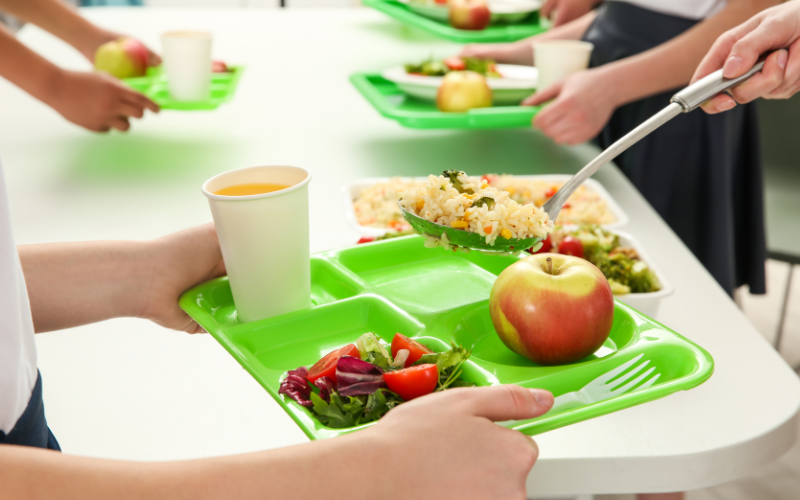Food Safety in School Cafeterias: Protecting Our Children’s Health

Every year, millions of people fall ill from foodborne illnesses.
Sadly, children are particularly susceptible to these.
A study published in the Journal of School Health highlighted the case of American children aged 5-17 years old, who account for a disproportionate number of foodborne illness cases in the country – 17.7 illnesses per 1,000 people compared to the national average.
These illnesses can range from mild discomfort to severe complications, with the CDC reporting an alarming number of hospitalisations and deaths annually.
The issue of food safety in schools isn’t limited to the United States.
While obtaining specific data from every country can be challenging, the global concern for foodborne illnesses highlights the potential risk in school cafeterias everywhere.
Thankfully, there are effective strategies to prevent these occurrences and safeguard the health of our children.
In this post, we explore food safety risks in schools and the most effective approaches to face them, focusing on Hazard Analysis and Critical Control Points (HACCP) principles.
Food Safety in School Cafeterias: Main Risks
Ensuring safe and healthy school lunches requires awareness of potential food safety hazards at every stage of the food handling process.
Here’s a breakdown of some key areas of concern:
-
Improper temperature control
- Danger Zone: Bacteria multiply rapidly at temperatures between 40°F (4°C) and 140°F (60°C), often referred to as the “danger zone.”
- Risk: Improperly cooked or held food within this temperature range can become breeding grounds for harmful bacteria like Salmonella, E. coli, and Staphylococcus aureus, leading to foodborne illness outbreaks.
- Examples: Undercooked meats, reheated leftovers not reaching safe temperatures, improperly stored perishable items.
-
Cross-contamination:
- Raw vs. Cooked: Transferring bacteria from raw ingredients (meat, poultry, eggs) to cooked or ready-to-eat foods can cause illness.
- Improper Handling: Using the same utensils or surfaces for raw and cooked foods without proper cleaning increases the risk.
- Personal Hygiene: Inadequate handwashing by staff can spread bacteria from hands to food.
-
Allergen mismanagement:
- Food Allergies: Schools need to be extra vigilant about managing food allergies among students. Accidental exposure can cause severe reactions.
- Labeling Errors: Improper food labelling or ingredient substitutions can put students with allergies at grave risk.
- Cross-Contact: Similar to bacteria, allergens can transfer from one food to another through shared equipment or surfaces.
-
Perishable food storage:
- Improper Storage: Storing perishable foods at incorrect temperatures can accelerate spoilage and increase the risk of bacterial growth.
- Stock Rotation: Not following FIFO (First In, First Out) principles can lead to outdated food being served.
- Temperature Monitoring: Inadequate temperature monitoring of refrigerators and freezers can lead to undetected spoilage.
-
Inadequate cleaning and sanitation:
- Equipment and Surfaces: Improper cleaning and sanitation of food preparation surfaces, utensils, and equipment can harbor bacteria and increase the risk of contamination.
- Handwashing Facilities: Inadequate access to handwashing facilities or poor handwashing practices by staff can spread germs.
- Disinfection Procedures: Ineffective disinfection procedures for spills or contaminated areas can allow bacteria to persist challenging food safety in schools.
The Challenge of Volunteer Food Prep
While parent volunteers bring valuable support to schools, their lack of experience in commercial kitchens and food safety protocols can pose a potential risk.
- Limited training: Volunteers might not receive comprehensive training on food safety best practices, including proper hygiene, temperature control, and allergen management.
- Unfamiliarity with regulations: Food safety regulations can be complex, and volunteers might not be aware of specific rules governing school cafeterias.
- Unforeseen errors: Unintentional mistakes due to lack of experience, such as cross-contamination or improper handling procedures, can increase the risk of foodborne illnesses and pose a challenge to food safety in schools.

Balancing Volunteer Support with Food Safety in Schools:
Schools can mitigate the risks posed by volunteers by implementing the following strategies:
- Mandatory training: Provide mandatory food safety training for all volunteers involved in food preparation. This training should cover hygiene practices, temperature control, allergen management, and proper food handling procedures.
- Clear instructions: Develop clear and concise written instructions for each preparation task. Regularly review these instructions with volunteers.
- Supervision and support: Assign experienced staff to supervise volunteers, answer questions, and ensure adherence to food safety protocols.
- Focus on low-risk tasks: Assign volunteers to tasks that minimize food safety risks, such as portioning pre-cooked items or assembling pre-washed ingredients.
By fostering collaboration between schools, food safety professionals, and parent volunteers, educational institutions can leverage the benefits of volunteer support while prioritising food safety in schools.
HACCP: A Systematic Approach to Food Safety in School Canteens
The Hazard Analysis and Critical Control Points (HACCP) system offers a structured and scientific approach to ensuring food safety throughout the entire food handling process.
Here’s how HACCP principles can be applied in school cafeterias to address the challenges earlier mentioned:
-
Conduct a Hazard Analysis:
- Identify all potential biological, chemical, and physical hazards that could contaminate food at each stage, from receiving ingredients to serving meals. Examples include:
- Biological: Bacteria, viruses, parasites from raw ingredients or improper storage.
- Chemical: Cleaning chemicals contaminating food preparation surfaces.
- Physical: Glass shards, foreign objects accidentally getting into food.
-
Identify Critical Control Points (CCPs):
- Pinpoint the specific steps in the food handling process where controls can be implemented to prevent, eliminate, or reduce identified hazards to an acceptable level. Here are some CCP examples in school cafeterias:
- Cooking temperatures: Ensuring meat, poultry, and eggs reach safe internal temperatures to eliminate harmful bacteria.
- Cooling procedures: Rapidly cooling cooked foods to prevent bacterial growth.
- Reheating temperatures: Ensuring reheated leftovers reach safe temperatures throughout.
- Handwashing: Staff following proper handwashing procedures before and during food preparation.
- Allergen management: Effectively labelling and storing food to prevent allergen cross-contamination.
-
Establish CCP Limits:
- Define specific parameters for each CCP to ensure effective hazard control. Examples:
- Minimum internal temperature for cooked chicken: 165°F (74°C).
- Maximum time allowed for cooling cooked food to 41°F (5°C).
- Minimum acceptable chlorine level in cleaning solutions.

-
Monitoring Procedures:
- Establish procedures to continuously monitor each CCP and ensure adherence to the established limits. Examples include:
- Using thermometers to check internal food temperatures during cooking and reheating.
- Recording temperatures and other CCP data in a logbook.
- Regularly monitoring handwashing practices and the availability of handwashing supplies.
-
Corrective Actions:
- Develop a plan for corrective actions to be taken if a CCP limit is not met. Examples:
- Rejecting undercooked food or reheating it to the proper temperature.
- Discarding food stored at unsafe temperatures.
- Retraining staff on proper handwashing procedures.
-
Verification Procedures:
- Implement procedures to verify the effectiveness of the HACCP plan. Examples:
- Conducting regular internal audits of the HACCP system.
- Inviting external food safety professionals to conduct inspections.
- Reviewing and updating the HACCP plan as needed.
-
Record Keeping:
- Maintain comprehensive records of all CCP monitoring data, corrective actions taken, and verification activities. These records demonstrate the school’s commitment to food safety and can be helpful during inspections.
By implementing HACCP principles, schools can create a data-driven food safety culture, minimise the risks associated with volunteer involvement, and ultimately, ensure the safety of student lunches.
Automating Food Safety in Schools with Andy
If you work in the food service industry you know only too well how powerful a tool HACCP is for ensuring food safety in any type of commercial kitchen, incluing school cafeterias.
However, you probably also know that implementing it effectively requires ongoing vigilance and meticulous record-keeping.
Here’s where Andy – leading digital food safety assistant for organised hospitality – can make all the difference.
- Digital guidance: Andy provides real-time, step-by-step guidance on HACCP procedures. Staff can access clear instructions and best practices for each critical control point (CCP) directly on their tablets or mobile devices.
- Automated monitoring: Andy can integrate with digital sensors and automatically record CCP data like cooking temperatures and cooling times. This eliminates the need for manual logs and reduces the risk of human error.
- Real-Time Alerts: If a CCP limit is not met, Andy triggers instant alerts, allowing staff to take immediate corrective action, such as rejecting undercooked food or reheating to the proper temperature.
- Automated labelling: Andy can automate the generation of secondary expiry labels for pre-portioned or prepped ingredients. This ensures clear and accurate expiration dates are applied, minimising the risk of serving spoiled food.
- Allergen tracking: Andy can integrate with allergen databases, allowing for clear labelling of allergens on secondary packaging. This enhances transparency and minimises the risk of accidental exposure for students with allergies.
- Inventory management: By tracking ingredient usage and expiry dates, Andy helps prevent food waste and ensures optimal stock rotation (FIFO) to avoid serving outdated food.
- Digital reporting: Andy facilitates the quick and easy reporting of food safety incidents, including near misses, contamination events, or equipment malfunctions.
- Corrective action tracking: Andy tracks corrective actions taken for reported incidents, ensuring proper follow-through and preventing similar occurrences in the future.
- Trend analysis: By analysing incident data over time, Andy can help identify recurring issues and areas for improvement in food safety practices.
-
Effortless internal auditing:
- Automated data collection: Andy automatically collects and stores all HACCP data, including CCP monitoring records, corrective actions taken, and verification activities.
- Digital reporting tools: Andy generates comprehensive reports that summarise CCP data and incident history, simplifying internal audits and providing valuable insights for continuous improvement.
- Compliance assistance: The system helps ensure all necessary documentation is readily available for regulatory inspections, demonstrating the school’s commitment to HACCP compliance.
With Andy as their digital partner, schools can:
- Reduce the risk of human error in food safety procedures.
- Improve the efficiency and accuracy of HACCP implementation.
- Enhance communication and transparency around food safety protocols.
- Minimise the risk of foodborne illness outbreaks.
- Free up staff time from manual tasks for a focus on higher-level food quality initiatives.
Andy empowers schools to prioritise the safety of student lunches while streamlining food safety management and fostering a culture of continuous improvement.
In the words of Keep Food Safe: ” Everyone involved from the consumer, the law makers, the legal system, and most importantly the food handlers need to work together to keep food safe for everyone”.
So, let’s keep our wonderful children safe every single school lunch! With Andy!

